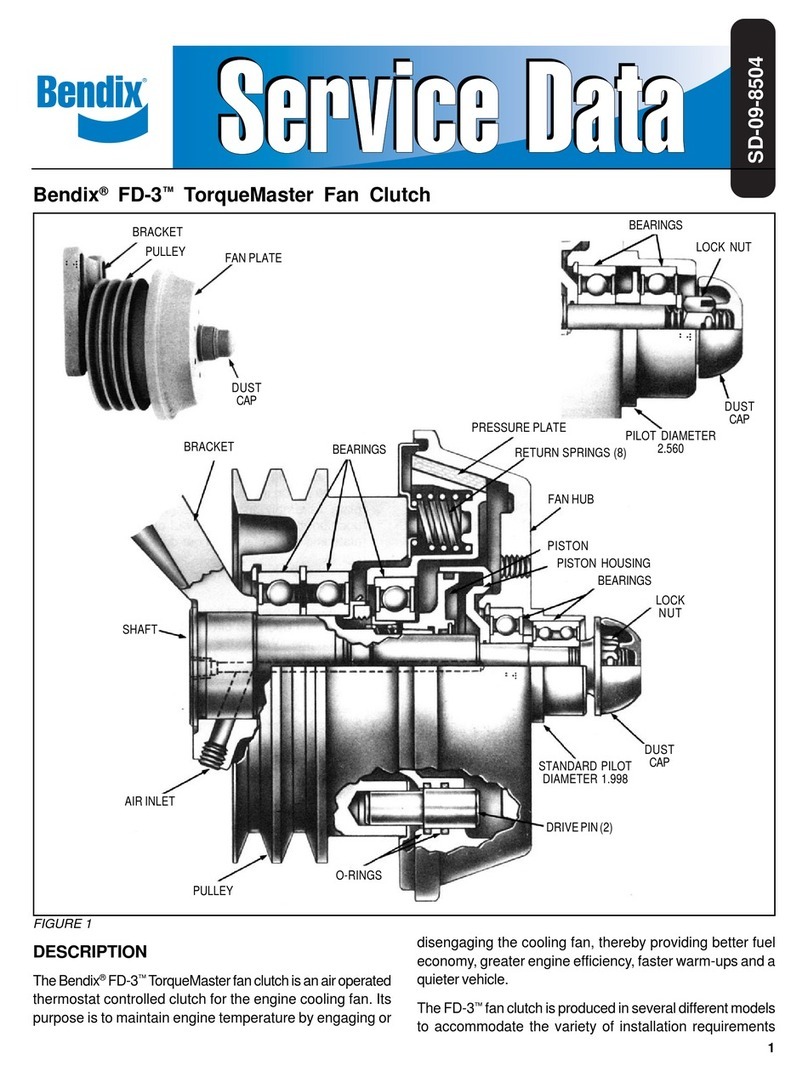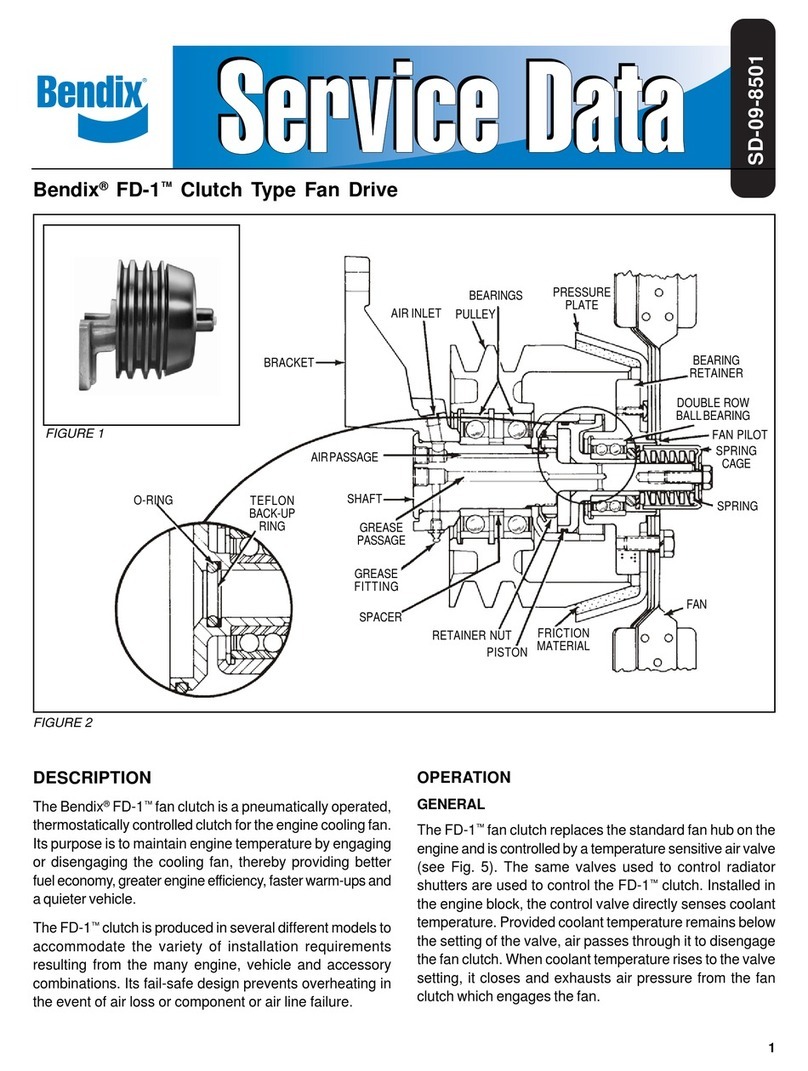
4
ThedurabilityoftheBendix®FD-2™fanclutchmatchesthat
of the vehicle’s engine. There is no need for periodic
maintenance;however,thefollowingservicechecks should
bemade to insureproper function ofthe fan clutch.
LINEHAUL VEHICLES:
Every 50,000 miles, 1,800 hours, or every six months,
whicheveroccursfirst,perform the service checks outlined
in this manual.
CITYDELIVERY
Every 15,000 miles, 300 hours, or every two months,
whicheveroccursfirst,perform the service checks outlined
in this manual.
SERVICE CHECKS
Beforeperforming the operating and leakage checks,apply
the vehicle parking brakes or chock the wheels.
OPERATIONAL
1. With the engine cold, the ignition off and at least 75 psi
air pressure in the brake system, note that the fan is
disengagedfromthepulleyand can be turned by hand.
Ifthefancan be turned, proceedto Step #2. If it cannot
beturned:
A. Drain all reservoirs and disconnect the air control
line leading to the fan clutch and apply at least 75
psi shop air pressure to the fan clutch.
B. If the fan cannot be turned, the clutch is defective
and must be repaired or replaced (see appropriate
section of this manual).
C. If the fan can now be turned; check the air lines
leadingto andfromthe thermostatic controlvalvefor
“kinks” or obstructions, and check the control valve
itselfaccording to the manufacturer’s instructions.
2. Afterperforming Step #1,drainallair pressure from the
brake system. Note that the fan is now engaged and
cannot be turned by hand. If it cannot be turned,
proceed to Step #3. If it can be turned, the clutch is
defectiveandmustberepairedor replaced.
3. Check the operation of the thermostatic control valve
byrunning theengineup tooperatingtemperature.Note
that the fan clutch engages when engine temperature
rises to normal or above and disengages after fan
cooling is accomplished. Normal engagement time
shouldnotexceedtwominutes.Ifengagementtimedoes
not exceed two minutes, proceed to Step #4. If
engagementtimedoesexceedtwo minutes:
A. If this test is being performed for the first time after
installation of the fan clutch, recheck the setting of
the thermostatic control valve and compare it with
thesetting of the engine coolant thermostat or in the
case of vehicles with radiator shutters, with the
setting of the shutter control. The fan clutch control
should always be 10° F. higher than the highest
setting.
B. Ifthefanclutchinstallationhassuccessfullypassed
this test before, but does not do so now, the
thermostaticcontrol valveisdefectiveand shouldbe
replaced.
4. With the clutch in the engaged position (control air
vented),check theconditionof thedrivepinsand mating
holes in the pressure plate by attempting to rotate the
fan clockwise and counter clockwise. If free play
exceeds5/16" (806 MM), fan clutch must be repaired or
replaced.
LEAKAGE CHECKS
In order to check for air leakage past the only two sliding
o-ringsintheFD-2™fanclutch it is necessary to disconnect
the single air control line.
Checkforleakagebyconnectinga90cu.in.reservoir(Bendix
part number 225000) with a gauge installed to the control
portofthefanclutch.Afterfillingthe90cu.in.reservoirwith
100psi, allow thepressuretostabilizeand observe the time
required for the reservoir pressure to drop to 90 psi. If the
time required is less than 1 minute, leakage is excessive
andrepairorreplacement is necessary.
WARNING! PLEASE READ AND FOLLOW
THESE INSTRUCTIONS TO AVOID
PERSONAL INJURYOR DEATH:
When working on or around a vehicle, the following
general precautions should be observed at all times.
1. Park the vehicle on a level surface, apply the
parking brakes, and always block the wheels.
Always wear safety glasses.
2. Stop the engine and remove ignition key when
working under or around the vehicle. When
working in the engine compartment, the engine
should be shut off and the ignition key should be
removed. Where circumstances require that the
enginebe in operation, EXTREME CAUTION should
be used to prevent personal injury resulting from
contact with moving, rotating, leaking, heated or
electrically charged components.
3. Do not attempt to install, remove, disassemble or
assemble a component until you have read and
thoroughly understand the recommended
procedures. Useonly the proper tools andobserve
all precautions pertaining to use of those tools.
4. If the work is being performed on the vehicle’s air
brake system, or any auxiliary pressurized air
systems,make certainto drainthe airpressure from
all reservoirs before beginning ANY work on the
vehicle. If the vehicle is equipped with an AD-IS™
air dryer system or a dryer reservoir module, be
sure to drain the purge reservoir.
5. Following the vehicle manufacturer’s
recommendedprocedures, deactivate theelectrical
system in a manner that safely removes all
electrical power from the vehicle.




























